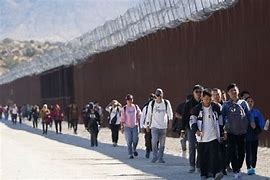In my last article, I didn’t forget to mention Trump’s idea of mass deportation! It’s just that this topic is so big it deserves its own conversation. So here we are! Let’s talk about what mass deportation could look like, how it might clash with sanctuary cities, and why history shows this idea may be tougher to pull off than it seems.

Imagine Trump starting his second term with plans to deport millions of undocumented immigrants. It’s not just another policy—it would turn lives upside down, split families apart, and shake up communities. If Trump’s plan moves forward, it could lead to a showdown with America’s “sanctuary cities,” like Los Angeles, New York, and Chicago. These cities limit their cooperation with federal immigration enforcement. They basically say, “We’re not going to help with mass deportations.” If Trump tries to enforce his plan, sanctuary cities would likely push back hard. You can already feel the tension building, right?
Here’s where it gets even more interesting. This battle between local and federal governments taps into the U.S. Constitution. The Tenth Amendment gives powers to the states that aren’t assigned to the federal government. Sanctuary cities argue they have the right to decide what their local police can or can’t do. But the federal government has powers too. Under Article I, Section 8, it has the authority to make immigration laws. Trump could argue that his plan is about national security and order. So who gets to decide? It’s a question that’s gone to the courts before and probably would again. For example, when Trump tried to cut funding to sanctuary cities during his first term, courts blocked it, saying only Congress could make those decisions. It’s like a tug-of-war with some high-stakes legal battles.

Now, what would happen if Trump’s plan actually went forward? We can learn a lot from other countries that tried similar things. Back in 1983, President Shagari deported around two million undocumented immigrants, mostly from Ghana. This was called the “Ghana Must Go” campaign. It was chaotic. Thousands of people had to leave quickly, taking only what they could carry. Border areas became overwhelmed, and it led to tensions between Nigeria and Ghana that lasted for years. While some thought this would help Nigeria’s economy, it didn’t have the positive impact many hoped for, and it left behind painful memories.

France has faced similar issues. In the 1970s, President Valéry Giscard d’Estaing started a policy to send back immigrant workers, mainly from North Africa. This led to protests, accusations of discrimination, and criticism from around the world. It showed how such policies can cause unrest and damage a country’s reputation.
In 2015, the Dominican Republic tried deporting thousands of Haitians and people of Haitian descent. Many of them were born and raised in the Dominican Republic, so they felt they had no real “home” to return to. This move raised human rights concerns globally and highlighted how these policies can deeply affect people’s lives.
Even in the U.S., we’ve seen something similar. During the Great Depression, President Herbert Hoover launched a program to deport Mexican immigrants, hoping it would create jobs for American citizens. But it didn’t go as planned. The move disrupted communities and left lasting scars. Today, it’s remembered as a tough and painful chapter in American history, one that didn’t fix the economic problems people hoped it would.

Another example is Brexit. You might wonder how Britain leaving the European Union relates to mass deportations in the U.S., but there’s a connection. After Brexit, many people had to leave the U.K. because of new residency rules. This sparked serious debates about who “belongs” and led to economic and social challenges. Industries like healthcare and farming found themselves without enough workers, affecting both the economy and community relationships. Britain faced the tough job of untangling itself from a web of people who had built their lives there. If Trump enforced mass deportations, the U.S. might face similar struggles. Industries that rely on immigrant labor, like agriculture, construction, and hospitality, could suddenly find themselves in trouble, trying to replace workers who have been part of these communities for years.
If Trump’s mass deportation plan happened, we’d likely see similar issues: family separations, chaos in communities, and industries scrambling to find workers. Sanctuary cities would probably resist, leading to standoffs with the federal government. Plus, the Constitution and the courts could get involved, setting off legal battles that could take a long time to resolve.
So, what do you think? Does mass deportation seem like a real solution, or could it create even bigger problems? History and legal battles remind us that this idea isn’t as simple as it might sound. From sanctuary city resistance to human rights concerns, mass deportation would likely reshape communities in big ways and bring tough questions all the way to the Supreme Court.
Share your story or advertise with us: Whatsapp: +2347068606071 Email: info@newspotng.com















